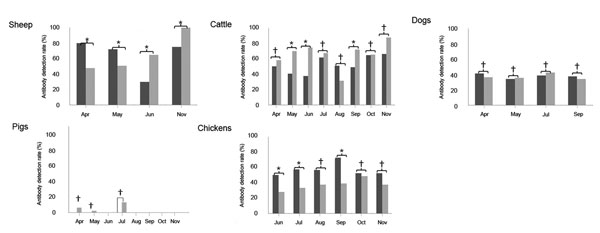Volume 19, Number 5—May 2013
Research
Severe Fever with Thrombocytopenia Syndrome Virus among Domesticated Animals, China
Figure 2

Figure 2. . . Serum antibody detection rate in domestic animals from Laizhou and Penglai counties, China, April–November 2011. Severe fever with thrombocytopenia syndrome virus N protein-specific antibodies were detected by double-antigen sandwich ELISA in serum samples of sheep, cattle, dogs, pigs, and chickens collected from Laizhou and Penglai counties in different months, and the antibody detection rates are presented. Black bars indicate samples from Laizhou; gray bars indicate samples from Penglai. The antibody detection rates in the 2 counties were compared (*p<0.05, †p>0.05).
1These authors contributed equally to this article.
Page created: April 03, 2013
Page updated: April 23, 2013
Page reviewed: April 23, 2013
The conclusions, findings, and opinions expressed by authors contributing to this journal do not necessarily reflect the official position of the U.S. Department of Health and Human Services, the Public Health Service, the Centers for Disease Control and Prevention, or the authors' affiliated institutions. Use of trade names is for identification only and does not imply endorsement by any of the groups named above.